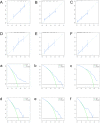Development and Validation of Novel Nomograms for Predicting Specific Distant Metastatic Sites and Overall Survival of Patients With Soft Tissue Sarcoma
- PMID: 33706618
- PMCID: PMC7958169
- DOI: 10.1177/1533033821997828
Development and Validation of Novel Nomograms for Predicting Specific Distant Metastatic Sites and Overall Survival of Patients With Soft Tissue Sarcoma
Abstract
Purpose: The goal of this study is to construct nomograms to effectively predict the distant metastatic sites and overall survival (OS) of soft tissue sarcoma (STS) patients.
Methods: STS case data between 2010 and 2015 for retrospective study were gathered from public databases. According to the chi-square and multivariate logistic regression analysis determined independent predictive factors of specific metastatic sites, the nomograms based on these factors were consturced. Subsequently, combined metastatic information a nomogram to predict 1-, 2-, and 3-year OS of STS patients was developed. The performance of models was validated by the area under the curve (AUC), calibration plots, and decision curve analyses (DCA).
Results: A total of 7001 STS patients were included in this retrospective study, including 4901 cases in the training group and the remaining 2,100 patients in the validation group. Three nomograms were established to predict lung, liver and bone metastasis, and satisfactory results have been obtained by internal and external validation. The AUCs for predicting lung, liver, and bone metastases in the training cohort were 0.796, 0.799, and 0.766, respectively, and in the validation cohort were 0.807, 0.787, and 0.775, respectively, which means that the nomograms have good discrimination. The calibration curves showed that the models have high precision, and the DCA manifested that the nomograms have great clinical application prospects. Through univariate and multivariate COX regression analyses, 8 independent prognosis factors of age, grade, histological type, tumor size, surgery, chemotherapy, radiatiotherapy and lung metastasis were determined. A nomogram was then constructed to predict the 1-, 2-, and 3-years OS, which has a good performance in both internal and external validations.
Conclusion: The nomograms for predicting specific metastatic sites and OS have good discrimination, accuracy and clinical applicability. The models could accurately predict the metastatic risk and survival information, and help clinical decision-making.
Keywords: metastasis; nomogram; overall survival; soft tissue sarcoma.
Conflict of interest statement
Figures






Similar articles
-
Score for the Risk and Overall Survival of Lung Metastasis in Patients First Diagnosed With Soft Tissue Sarcoma: A Novel Nomogram-Based Risk Assessment System.Technol Cancer Res Treat. 2022 Jan-Dec;21:15330338211066240. doi: 10.1177/15330338211066240. Technol Cancer Res Treat. 2022. PMID: 35006028 Free PMC article.
-
Early distinction of lymph node metastasis in patients with soft tissue sarcoma and individualized survival prediction using the online available nomograms: A population-based analysis.Front Oncol. 2022 Dec 7;12:959804. doi: 10.3389/fonc.2022.959804. eCollection 2022. Front Oncol. 2022. PMID: 36568161 Free PMC article.
-
Evaluation of Risk Factors, and Development and Validation of Prognostic Prediction Models for Distant Metastasis in Patients With Rectal Cancer: A Study Based on the SEER Database and a Chinese Population.Cancer Control. 2024 Jan-Dec;31:10732748241303650. doi: 10.1177/10732748241303650. Cancer Control. 2024. PMID: 39579008 Free PMC article.
-
A New Online Dynamic Nomogram: Construction and Validation of a Predictive Model for Distant Metastasis Risk and Prognosis in Patients with Gastrointestinal Stromal Tumors.J Gastrointest Surg. 2023 Jul;27(7):1429-1444. doi: 10.1007/s11605-023-05706-9. Epub 2023 May 25. J Gastrointest Surg. 2023. PMID: 37231240 Review.
-
Prognostic nomogram and risk factors for predicting survival in patients with pT2N0M0 esophageal squamous carcinoma.Sci Rep. 2023 Mar 26;13(1):4931. doi: 10.1038/s41598-023-32171-w. Sci Rep. 2023. PMID: 36967413 Free PMC article. Review.
Cited by
-
Prognostic Role of OX40, LAG-3, TIM-3 and PD-L1 Expression in Bone and Soft Tissue Sarcomas.J Clin Med. 2024 Jun 20;13(12):3620. doi: 10.3390/jcm13123620. J Clin Med. 2024. PMID: 38930150 Free PMC article.
-
Prediction tools for the personalized management of soft-tissue sarcomas of the extremity.Bone Joint J. 2022 Sep;104-B(9):1011-1016. doi: 10.1302/0301-620X.104B9.BJJ-2022-0647. Bone Joint J. 2022. PMID: 36047022 Free PMC article. Review.
-
Nomograms predicting local and distant recurrence and disease-specific mortality for R0/R1 soft tissue sarcomas of the extremities.Front Oncol. 2022 Sep 20;12:941896. doi: 10.3389/fonc.2022.941896. eCollection 2022. Front Oncol. 2022. PMID: 36203418 Free PMC article.
-
A Mixed-Methods Study to Better Measure Patient-Reported Pain and Fatigue in Soft Tissue Sarcoma.Oncol Ther. 2023 Mar;11(1):129-143. doi: 10.1007/s40487-022-00219-y. Epub 2023 Jan 12. Oncol Ther. 2023. PMID: 36633810 Free PMC article.
-
Impact of Smoking History on Pulmonary Metastasis-free Survival in Patients With Soft-tissue Sarcoma.Cancer Diagn Progn. 2021 May 3;1(2):89-94. doi: 10.21873/cdp.10013. eCollection 2021 May-Jun. Cancer Diagn Progn. 2021. PMID: 35403129 Free PMC article.
References
-
- Jemal A, Siegel R, Xu J, Ward E. Cancer statistics, 2010. CA A Cancer J Clin. 2010, 60(5):277–300. - PubMed
-
- von Mehren M, Randall R, Benjamin R, et al. Soft tissue sarcoma, version 2.2018, NCCN clinical practice guidelines in oncology. J Nati Compr Canc Net. 2018, 16(5):536–563. - PubMed
-
- Callegaro D, Miceli R, Mariani L, Raut C, Gronchi A. Soft tissue sarcoma nomograms and their incorporation into practice. Cancer. 2017;123(15):2802–2820. - PubMed
-
- Krishnan C, Kim H, Park J, Han I. Outcome after surgery for extremity soft tissue sarcoma in patients presenting with metastasis at diagnosis. Am J Clin Oncol. 2018;41(7):681–686. - PubMed
Publication types
MeSH terms
LinkOut - more resources
Full Text Sources
Other Literature Sources
Medical

